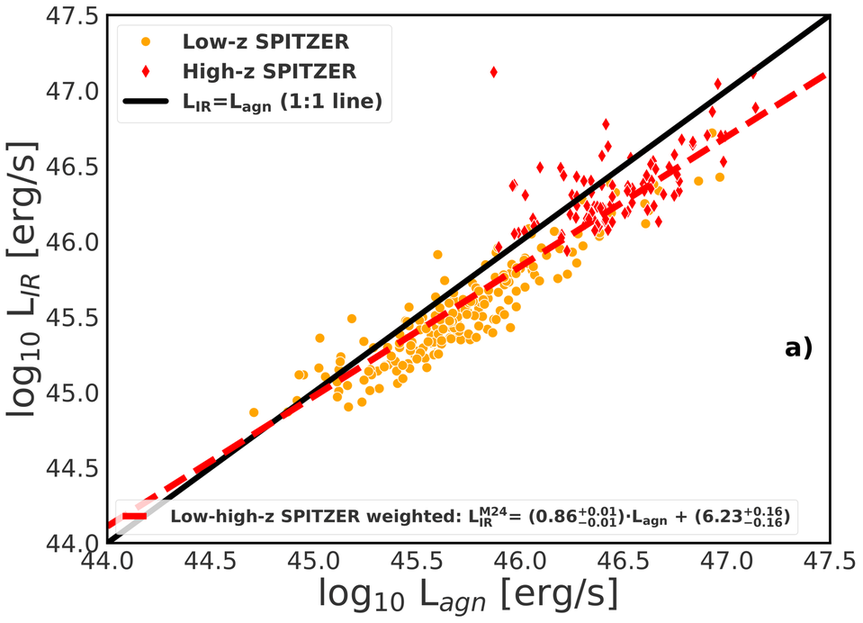Astronomy Object of the Month: 2023, November
< previous Archive next >
Covered Quasars
Quasars are some of the brightest objects we know of in the Universe. Although they were originally thought to be near stars, we now know
that they are galaxies with a very bright source at the center –
a super-massive black hole that accretes (absorbs) such large amounts of matter that some of it is converted into energy, to which the entire galaxy owes its extraordinary brightness. Thanks to their brightness, we can observe quasars that are very far away from us. This allows us to try to create universal relationships that can be used to measure cosmological parameters (coefficients that help determine the geometry of the Universe). At first, however, such a relationship must be calibrated, that is, it is necessary to know what exactly can affect it.

We focused our analysis on the so-called 'covering factor' (CF) – a parameter that determines how much of a quasar's central source is visible and how much is covered by the (dusty) torus – a dusty, donut-shaped structure surrounding the black hole. Graphically, this is shown in Figure 1. There are different ways to calculate the covering factor, but based on the available data for our sample, we decided to use a ratio of two luminosities – infrared luminosity (which consists of radiation from the dust torus), and optical luminosity (radiation from the closest surroundings of the super massive black hole). We tested whether the CF depends on the redshift, i.e. (in simple terms) whether farther objects (High-z) have a different CF from closer ones (Low-z). We found that for objects that have similarly massive super massive black holes (they have similar physical properties), we see no differences between the values for near and far quasars.
We checked the relationship between infrared and optical brightness. For the group of objects with the best observations, the relationship is well determined. From Figure 2, one can see that closer objects (yellow points) have lower brightnesses than farther objects (red points). We were able to fit a single line that describes both groups of quasars well.
 Illustration 2: Correlation between infrared luminosity (vertical axis) and optical luminosity (horizontal axis). Yellow points are objects closer to the quasars (low-z), and red diamonds are farther away objects. A slope of about ~0.9 suggests a very close relationship between both brightnesses. This gives hope for applying the relationship to objects at further redshifts. Using the methodology from the Risalitti & Lusso 2015 paper, it can be used for cosmological applications.
Illustration 2: Correlation between infrared luminosity (vertical axis) and optical luminosity (horizontal axis). Yellow points are objects closer to the quasars (low-z), and red diamonds are farther away objects. A slope of about ~0.9 suggests a very close relationship between both brightnesses. This gives hope for applying the relationship to objects at further redshifts. Using the methodology from the Risalitti & Lusso 2015 paper, it can be used for cosmological applications.
The considerations so far raise another question, the answer to which we will seek in our next work. What type of contamination can affect the discovered relationship? Based on our analysis, we suspect that one important factor is the surroundings of the supermassive black hole – the so-called polar dust (polar dust) located near the poles of the black hole. In addition, the host galaxy may give stellar contributions, or the cold dust present in the galaxy may affect infrared emission. We seek answers to these and other questions in the current analysis.
Original publication:
Mateusz Rałowski, Krzysztof Hryniewicz, Agnieszka Pollo and Łukasz Stawarz, Covering factor in AGNs: evolution versus selection, arXiv:2311.00072 (2023). The results will be soon published in Astronomy & Astrophysics.
The research was conducted at the Department of Stellar and Extragalactic Astronomy of the Jagiellonian University’s Astronomical Observatory (OAUJ).
|
Mateusz Rałowski Astronomical Observatory Jagiellonian University M.Rałowski [@] doctoral.uj.edu.pl |


